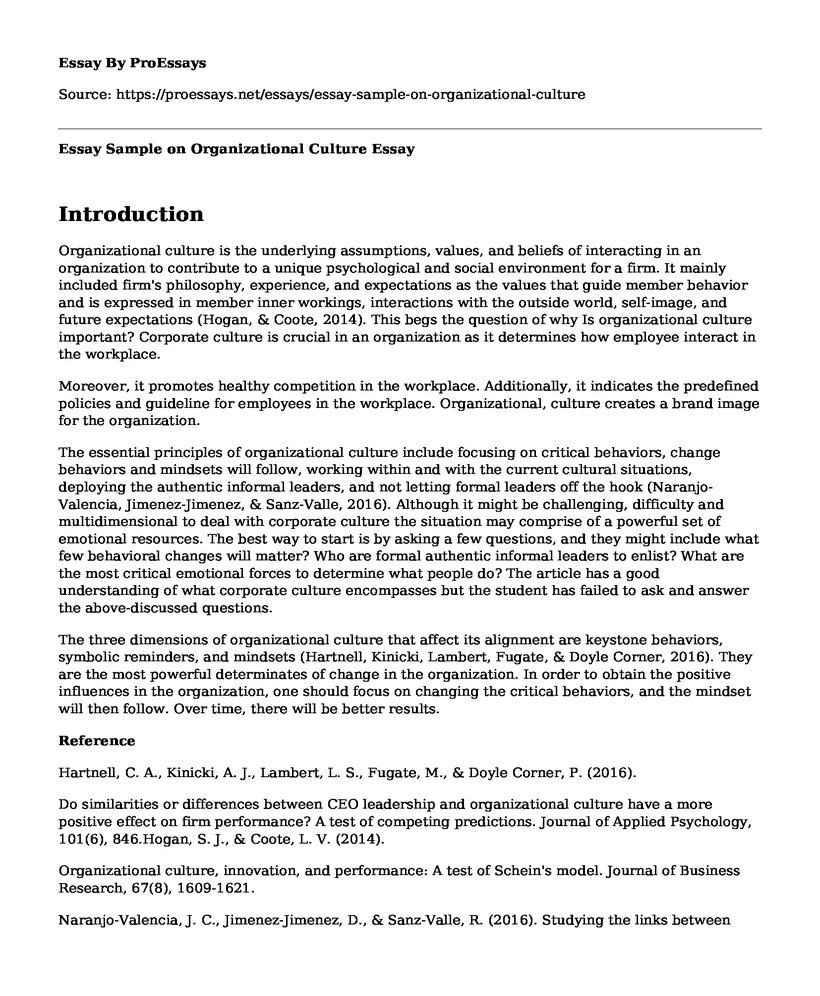Introduction
Organizational culture is the underlying assumptions, values, and beliefs of interacting in an organization to contribute to a unique psychological and social environment for a firm. It mainly included firm's philosophy, experience, and expectations as the values that guide member behavior and is expressed in member inner workings, interactions with the outside world, self-image, and future expectations (Hogan, & Coote, 2014). This begs the question of why Is organizational culture important? Corporate culture is crucial in an organization as it determines how employee interact in the workplace.
Moreover, it promotes healthy competition in the workplace. Additionally, it indicates the predefined policies and guideline for employees in the workplace. Organizational, culture creates a brand image for the organization.
The essential principles of organizational culture include focusing on critical behaviors, change behaviors and mindsets will follow, working within and with the current cultural situations, deploying the authentic informal leaders, and not letting formal leaders off the hook (Naranjo-Valencia, Jimenez-Jimenez, & Sanz-Valle, 2016). Although it might be challenging, difficulty and multidimensional to deal with corporate culture the situation may comprise of a powerful set of emotional resources. The best way to start is by asking a few questions, and they might include what few behavioral changes will matter? Who are formal authentic informal leaders to enlist? What are the most critical emotional forces to determine what people do? The article has a good understanding of what corporate culture encompasses but the student has failed to ask and answer the above-discussed questions.
The three dimensions of organizational culture that affect its alignment are keystone behaviors, symbolic reminders, and mindsets (Hartnell, Kinicki, Lambert, Fugate, & Doyle Corner, 2016). They are the most powerful determinates of change in the organization. In order to obtain the positive influences in the organization, one should focus on changing the critical behaviors, and the mindset will then follow. Over time, there will be better results.
Reference
Hartnell, C. A., Kinicki, A. J., Lambert, L. S., Fugate, M., & Doyle Corner, P. (2016).
Do similarities or differences between CEO leadership and organizational culture have a more positive effect on firm performance? A test of competing predictions. Journal of Applied Psychology, 101(6), 846.Hogan, S. J., & Coote, L. V. (2014).
Organizational culture, innovation, and performance: A test of Schein's model. Journal of Business Research, 67(8), 1609-1621.
Naranjo-Valencia, J. C., Jimenez-Jimenez, D., & Sanz-Valle, R. (2016). Studying the links between organizational culture, innovation, and performance in Spanish companies. Revista Latinoamericana de Psicologia, 48(1), 30-41.
Cite this page
Essay Sample on Organizational Culture. (2022, Nov 01). Retrieved from https://proessays.net/essays/essay-sample-on-organizational-culture
If you are the original author of this essay and no longer wish to have it published on the ProEssays website, please click below to request its removal:
- Essay Sample on Chrysler Bailout Decision
- Hospital Risk Management: A Case Study of Hospital for Special Surgery (HSS)
- Essay on Calhoun's "Positive Good" Speech
- Impacts of Globalization and Technology on the Performance of Dunkin Donutsre
- DBA: Forms of Business Ownership Essay
- Influence of Higher Education Changing Environment on Students' Decision-Making
- Essay on COBIT: Bridging the Gap Between Technical Matters, Business Risks and Control Requirements







